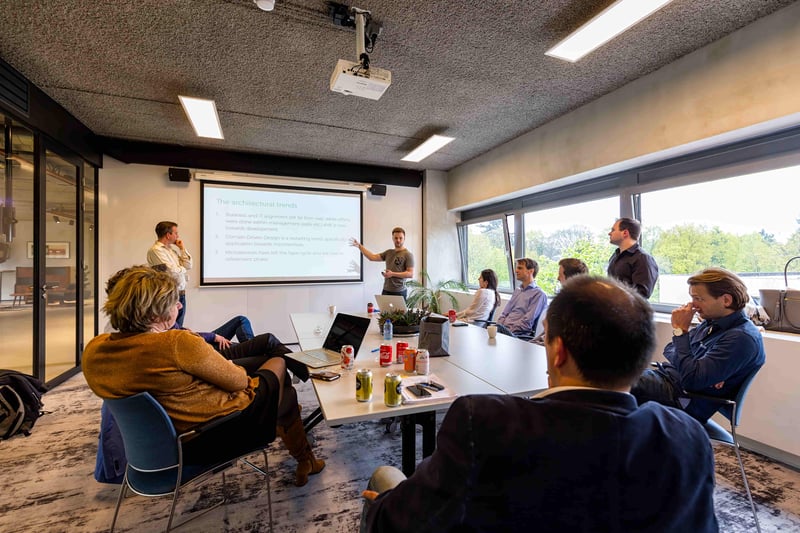To ensure the success of your digital transformation journey, it is crucial to upskill your employees and teams. The first step before upskilling your team is to find the most suitable learning program for your organization. A well-designed learning program enables employees to acquire the necessary skills and knowledge to adapt to new technologies and processes. Conversely, opting for an unsuitable program can result in frustration and disengagement.
The challenge, however, is finding the perfect mix of different learning solutions that will provide the best learning experience for your participants. With a wide range of products available, it's overwhelming to find the most suitable learning program for your organization. This article will shed some light on how to find the right mix of learning products that enable you to reap the full benefits of your digital transformation.
Design with the end in mind
Before diving into the different learning products available, it's essential to understand what you want to achieve with your learning program. The revised Bloom's taxonomy can help you identify different stages along the learning journey. The revised Bloom's taxonomy entails six stages a learner goes through:
- Remembering: At this level, trainees need to recall or recognize information. To facilitate memorizing at this stage, you can provide them with a wide variety of different activities, including listing facts, rote learning, flashcards, or recall quizzes.
- Understanding: Trainees should be able to explain concepts using their own words, which could be trained through some activities, such as summarizing texts, interpreting new learnings in their own words, explaining them to someone else, or participating in Q&A sessions.
- Applying: At this stage, students should be able to apply what they’ve learned in new circumstances. Activities that can facilitate learning at this stage might include problem-solving tasks, role-plays, or the application of a concept or theory to a real-world scenario.
- Analyzing: This stage requires trainees to break down information into small parts and figure out the interrelationships of the information. Trainees need to be more proactive in comparing different theories, sorting out the relationship between different concepts, or forming their criticism of the new concepts.
- Evaluating: This entails making judgments or forming opinions about the value of information. Trainees could be tasked with critiquing an article, developing an argument for or against a particular statement, or assessing the validity of different sources of information.
- Creating: At this highest level, trainees should be able to create new products or points of view, which could be achieved by designing a project, proposing a solution to a problem, creating a new model or theory, or writing a report or creative work.
 Source: Bloom's Taxonomy
Source: Bloom's Taxonomy
It is important to realize that not all individuals in an organization need to achieve the highest level of Bloom's Taxonomy ("Creating") in comprehending every area of knowledge required for transformation. The required level of understanding may differ based on the person's specific role and responsibilities.
Imagine an organization that is undergoing a DevOps transformation journey. Software developers involved in coding and system design may need to reach a high level of mastery (including "Creating") in understanding DevOps practices and tools. They may need to be able to create new solutions, adapt existing ones, and understand the implications of different (technical) decisions that they make.
On the other hand, other stakeholders in the organization (like managers, product owners, and scrum masters) may not need to reach the "Creating" stage. Instead, they might need to reach the "Understanding" or "Applying" stage, where they can grasp the core principles of DevOps, understand its benefits, and apply this understanding in their decision-making or support processes.
With that being said, a broad understanding of a topic across all levels of the organization can help drive a successful transformation. It’s paramount to foster a culture where everyone has at least a basic understanding of the definition and benefits of DevOps, thus overcoming resistance to change and ensuring that everyone is pulling in the same direction.
Although it is advantageous for individuals to have a basic understanding of the transformation, not everyone needs to achieve level 6 in Bloom's Taxonomy. The level of knowledge required depends on an individual's role and responsibilities within the organization during the transformation process.
When developing a learning program for your transformation, it's crucial to determine the trainees' personas and the level of knowledge they need to acquire. By identifying these factors, you can create a learner-centric program that caters to their specific needs.
The variety of different tools
There is a wide range of learning products available to help achieve different learning objectives. Some common options include e-learning, classroom learning, workshops, coaching, and hands-on learning products.
E-learning, offered by platforms like Pluralsight or A Cloud Guru, is a popular choice for digital transformation. It allows employees to learn at their own pace and on their own time, making it convenient and cost-effective. However, the engagement level of the content may be limited.
Classroom learning, on the other hand, encourages interaction between participants and trainers. It is ideal for topics that require discussions or hands-on practice. The main advantage of classroom learning is that it can be tailored to your organization's specific needs.
Workshops are similar to classroom learning but focus more on practical applications. They allow participants to apply the knowledge gained from other learning settings, such as e-learning or classroom training, to real-life scenarios.
Coaching provides a personalized one-on-one learning experience. It is a good option for employees who require individual attention or are struggling with specific concepts.
Hands-on learning products, like Instruqt, enable participants to learn by doing. This approach allows trainees to absorb technical skills more easily and is often more engaging than traditional e-learning methods.

Find the Right Level of Tools and Education
Based on the persona you have identified and the learning solutions that you have at your disposal, it is time to design the learning journey. Ideally, your learning journey should contain a mix of all the named learning formats to create an engaging experience.
Once you've identified the best mix of products, the next crucial step is to specify the degree of difficulty of the training. If the classes are too easy, participants may get bored and disengaged. If they're too difficult, participants may become frustrated and discouraged. It’s crucial to first identify the difficulty level and find the right tools before designing the learning journey.
Conclusion
Digital transformation is a process that requires learning and development. By identifying the level of knowledge that is needed for different individuals and mapping the available learning tools based on that, you can create the best learning experience to upskill your employees. Ensure that the learner's journey remains at the core of the program, as understanding is a prerequisite for effective application and creation.





